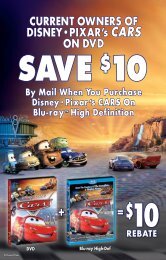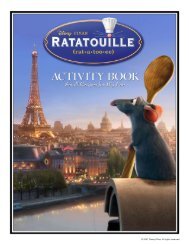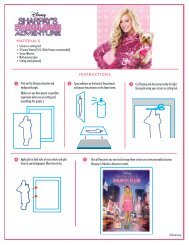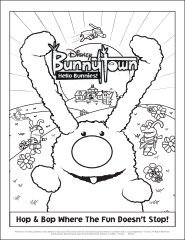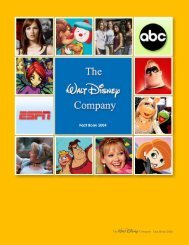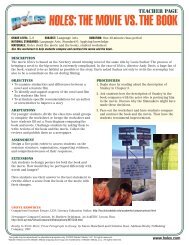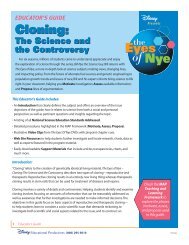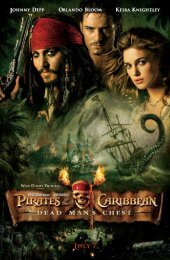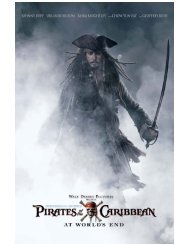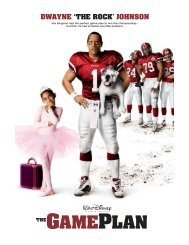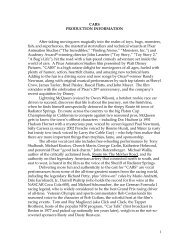introduction - Disney
introduction - Disney
introduction - Disney
You also want an ePaper? Increase the reach of your titles
YUMPU automatically turns print PDFs into web optimized ePapers that Google loves.
T H E M A T I C C O N N E C T I O N S<br />
A first-time, younger viewer may not immediately grasp the themes of the<br />
film or some of the more subtle ways in which its characters are connected.<br />
These activities are designed to promote examinations of the film’s specific<br />
themes.<br />
Mobility is Freedom<br />
Begin by asking students to identify all the characters who literally “move”—you will most<br />
likely receive replies that include the following names:<br />
John “Yac” Yacobellis<br />
(bike messenger)<br />
Patty Wagstaff (aerobatic pilot)<br />
Amelia Rudolph (cliff dancer)<br />
The Vasquez Family (salsa dancers)<br />
Erik Weihenmayer (blind climber)<br />
Rick and Dick Hoyt (Boston Marathon runners)<br />
The Power In-Between<br />
At one point during her segment, cliff dancer Amelia Rudolph remarks, “There is a lot of<br />
power in things that are between things.” This remark applies perfectly to the power of the<br />
Bandaloop Cliff Dancers, since they are “in-between” climbers and dancers. The initiallyseeming<br />
odd combination of passions is what gives cliff dancing its power and beauty.<br />
Ask students to consider the ways in which America’s Heart & Soul explores “the<br />
power” of “in-between things.” Which characters combine two types of materials or<br />
passions to produce a powerful new endeavor? The actions of characters such as Paul Stone<br />
(Explosive Artist) and Dan Klennart (Junk Artist) may be good starting points for a discussion<br />
before moving into ones about other characters who<br />
have found an “in-between” among more abstract things,<br />
such as religion and music (Mosie Brooks), prison and<br />
the Olympics (Michael Bennet) or business and pleasure<br />
(Ben Cohen).<br />
7<br />
Discuss the ways in which these characters’ mobility reflects their<br />
personalities as well as their values: What does a viewer come to understand<br />
about why Amelia Rudolph loves cliff dancing or why Patty<br />
Wagstaff loves completing such challenging stunts? You may want to<br />
refer to some or all of the following quotations from the film:<br />
“I always felt like a leaf floating in the wind; even though it’s the most freedom you<br />
could ever have, it’s also the most structured, because in aerobatic flying, one mistake<br />
could be your last.”<br />
Patty Wagstaff (Aerobatic Pilot)<br />
“Mobility is freedom.”<br />
Rick Hoyt (Boston Marathon runner and father of Dick Hoyt)<br />
“Once I’m anchored in and understand the system, I’m free.”<br />
Amelia Rudolph (Cliff Dancer)<br />
After a discussion of the thrills of literal mobility, consider one about<br />
figurative mobility: Which characters have figuratively “moved” in order<br />
to pursue their passions? The following is a partial list of characters whose<br />
stories explore the importance of figurative mobility:<br />
Roudy Roudebush (moved from alcoholism to sobriety)<br />
Mosie Burks (moved from daughter to mother of six)<br />
Ben Cohen (moved from frequently-fired odd-jobber<br />
to CEO of Ben & Jerry’s)<br />
Welton Steelworkers (moved from employees to owners)<br />
Michael Bennet (moved from convict to Captain of<br />
U.S. Olympic Boxing Team)<br />
Ask students to consider the effects of these “moves” on the characters: how<br />
did changes in the directions of their lives lead togreater freedom<br />
and self-fulfillment? Finally, ask students to compose (and perhaps share) some<br />
of their own “Stories of Movement” in which they detail some of the literal and<br />
figurative movements they have experienced.<br />
Finding One’s Passion<br />
In the book America’s Heart & Soul, director Louis<br />
Schwartzberg remarks: When people watch America’s<br />
Heart & Soul or read this book, I hope they hear the<br />
call to “find their passion.” If you find your passion, I<br />
think you’ll be happy, it will rejuvenate your soul, and<br />
you can still make a living.<br />
After reviewing the above quotation with your students, ask<br />
them to identify the segments of the film that they found to be<br />
especially poignant, inspiring—or just plain fun. Then ask your<br />
students to consider the ways in which the film encourages the<br />
viewer to become as excited about the characters’ passions as the<br />
passions themselves: How, for example, does the film’s cinematography,<br />
editing and soundtrack convey Patty Wagstaff’s rush<br />
of adrenaline when she performs her stunts? Then have students<br />
select other segments of the film and explain—in as much de-<br />
tail as possible—how the elements of successful filmmaking<br />
combine to convey the theme of the individual segment,<br />
whether it be the quiet introspection of Minnie Yancy as she<br />
weaves or the energy of the members of the Vasquez Family<br />
as they dance. Students may wish to review clips from the<br />
film or you may wish to show some in class while supplying<br />
your own “DVD commentary.”<br />
Finally, ask students to identify one of their passions—or a<br />
passion they would love to pursue in the future. What is<br />
it about this passion that appeals to them? To what extent is the pursuit of this passion<br />
related to the freedoms we currently enjoy as Americans? Is there anything inhibiting their<br />
pursuit of their passions?<br />
8



